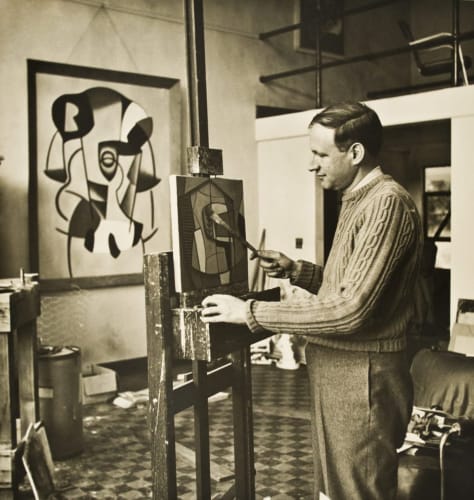A writer and editor as well as a painter and sculptor, George L. K. Morris used various publications as platforms for advocating abstract art during the 1930s and 1940s. He believed that abstraction offered limitless possibilities for the twentieth century and set about to interpret new forms and ideas in historical terms so they would have special meaning for an American audience
Morris was a member of the “Park Avenue Cubists.” He came from a privileged background that allowed him to travel to Europe and be current with the avant garde European scene. In the spring of 1929 he went to Paris with cousin Albert Gallatin and stayed after Gallatin's departure to take Léger's and Ozenfant's classes at the Académie Moderne. In Paris he became a confirmed abstractionist, In his work illusionistic space in figurative paintings yielded to uptilted planes and increasingly to a Cubist fracturing of the picture plane.
He continued to travel frequently, often accompanying Gallatin to Paris to buy work for the Gallery of Living Art. He became friendly with Jean Hélion, who provided introductions to Braque, Picasso, and Brancusi. In 1937 he joined forces with Gallatin, Sophie Taeuber-Arp, and Cesar Domela, to publish an art magazine called Plastique. There, and in the pages of Partisan Review where he served as an editor between 1937 and 1943. Morris spoke of the cyclical nature of art history and placed contemporary art squarely within a framework of historical evolution.
The time is ripe, Morris continued, "for a complete beginning. The bare expressiveness of shape and position of (the) shape must be pondered anew; the weight of color (and) the direction of line and angle can be restudied until the roots of primary tactile reaction shall be perceived again." Contemporary artists, he maintained, "must strip art inward to those very bones from which all cultures take their life."
After 1947, he devoted his time almost exclusively to painting and sculpture, although he continued to write occasionally. A founding member of the American Abstract Artists, in the late 1940s he also served as the group's president, arranging exhibitions in Europe and Japan as well as in the United States. He continued to be active with the group during the 1950s and 1960s.
Morris sought a synthesis of Cubist structure and primitive form. He argued for the concrete, and in his paintings juxtaposed hard-edged circular and angular forms in completely nonobjective compositions. Though Morris exhibited with some frequency during the 1930s and 1940s, his paintings and sculpture received greatest recognition after the war. He remained steadfast in his devotion to his variant form of Cubism, even though many of his friends and colleagues turned to more expressionist styles in the postwar years. He believed authentic American abstraction needed to reflect the nation’s unique history and culture. Indian Compositions, started a series increasingly reductive works, which represents the artist’s decades-long exploration of the Native American experience through the lens of biomorphic form and line.
In the 50's Morris' paintings of receding checkerboard patterns anticipated Op Art and in the 60's he enjoyed his greatest success in the art world. Morris was fatally injured in an automobile accident in Stockbridge, Massachusetts in 1975. His work is in the collections of the Metropolitan Museum of Art, The Whitney Museum, The Brooklyn Museum, The Philadelphia Museum of Art and the Carnegie Art Institute.
